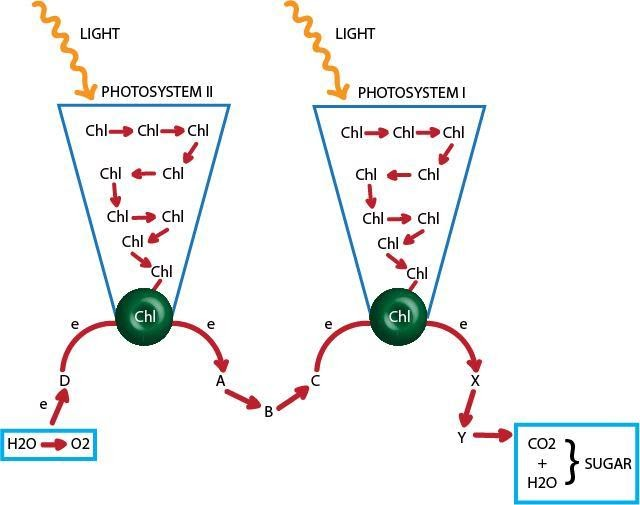
What does a plant convert electromagnetic energy to?
Answer
511.5k+ views
Hint: All of the energy from the Sun arrives on Earth as part of a large collection of energy called the electromagnetic radiation spectrum. Plants absorb this electromagnetic energy with the help of pigments embedded on its surface. This energy is used to create organic molecules, the fuel required to survive.
Complete answer:
Photosynthesis is the process that converts electromagnetic energy coming from the sun in the form of light into chemical energy stored in the chemical bonds of glucose, the end product of photosynthesis. The chlorophyll pigments present on the surface of the leaves of plants absorb the incoming electromagnetic energy. Consider two photosystems I and II. The donor for photosystem II takes the electrons in water (obtained from the soil through roots) to produce oxygen.
$H_2$O to $O_2$
The acceptor of photosystem II passes these electrons to the donor of photosystem I. The acceptor of the photosystem I pass the electron for the formation of sugar.
$CO_2$ + $H_2$O = sugar
The sugar produced is phosphoglyceraldehyde (PGAL). PGAL produces glucose further on in the process, which the plant uses as fuel. These reactions are termed carbon-fixation reactions.
Note:
$CO_2$ + 6$H_2$O → $C_6H_{12}O_6$ + 6$O_2$ is the formula of photosynthesis which is initiated when electromagnetic energy from the sun falls on the chlorophyll pigments of the plants. Light dependent reactions and the Calvin cycle are the two stages of photosynthesis.

Figure 1: Conversion of EM energy
Complete answer:
Photosynthesis is the process that converts electromagnetic energy coming from the sun in the form of light into chemical energy stored in the chemical bonds of glucose, the end product of photosynthesis. The chlorophyll pigments present on the surface of the leaves of plants absorb the incoming electromagnetic energy. Consider two photosystems I and II. The donor for photosystem II takes the electrons in water (obtained from the soil through roots) to produce oxygen.
$H_2$O to $O_2$
The acceptor of photosystem II passes these electrons to the donor of photosystem I. The acceptor of the photosystem I pass the electron for the formation of sugar.
$CO_2$ + $H_2$O = sugar
The sugar produced is phosphoglyceraldehyde (PGAL). PGAL produces glucose further on in the process, which the plant uses as fuel. These reactions are termed carbon-fixation reactions.
Note:
$CO_2$ + 6$H_2$O → $C_6H_{12}O_6$ + 6$O_2$ is the formula of photosynthesis which is initiated when electromagnetic energy from the sun falls on the chlorophyll pigments of the plants. Light dependent reactions and the Calvin cycle are the two stages of photosynthesis.

Figure 1: Conversion of EM energy
Recently Updated Pages
Master Class 11 Business Studies: Engaging Questions & Answers for Success

Master Class 11 English: Engaging Questions & Answers for Success

Master Class 11 Computer Science: Engaging Questions & Answers for Success

Master Class 11 Social Science: Engaging Questions & Answers for Success

Master Class 11 Maths: Engaging Questions & Answers for Success

Master Class 11 Biology: Engaging Questions & Answers for Success

Trending doubts
Differentiate between an exothermic and an endothermic class 11 chemistry CBSE

One Metric ton is equal to kg A 10000 B 1000 C 100 class 11 physics CBSE

Explain zero factorial class 11 maths CBSE

State the laws of reflection of light

What is 1s 2s 2p 3s 3p class 11 chemistry CBSE

Difference Between Prokaryotic Cells and Eukaryotic Cells




